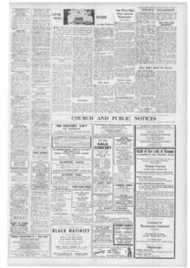Page 8, 22nd February 1963
Page 8

Report an error
Noticed an error on this page?If you've noticed an error in this article please click here to report it.
Tags
Share
Related articles
Sutherland : 'eloquent Protestor'
A Challenge For Graham Sutherland
Space And Colour At E. Acton
New Church For 1,200 In London
Parish And Community No. 11: St Aidan's, East Acton
Christ is crucified in E. Acton
By Iris Conlay
GRAHAM SUTHERLAND has now made three great paintings of the Crucifixion. The last one was unveiled last Sunday at St. Aidan's Church, East Acton, by Mgr. Thomas Holland, coadjutor bishop of Portsmouth. (Sutherland's first crucifixion hangs in the Anglican church of Northampton, his second is a part of the tapestry of Christ in Glory at Coventry Cathedral.) A Catholic himself, this is the first commission Sutherland has had from a Catholic church.
Although this Crucifixion has characteristics in common with both the earlier ones, it is much more than a synthesis of both. Its impact is terrific. One is conscious of nothing else when one first enters the church: there it is pulsating, physical agony hanging on a vermilion wall. It rocks all judgment. It tears one apart by being at the same lime so terrible—much, much more terrible than anything plain realism could show—and so glorious and glowing and triumphant.
EXULTATION
Christ's body may here have been brought to the depth of degradation as death's taut fingers crush the torso into a hollow cage of protruding ribs which can barely contain the gaping heart, pull out the arms like knotted ropes, strip all flesh from the legs till they are only broken sticks of weathered bone and set she face in its last twitch of awful rAin, yet the grave horror of it all is utterly remote from anything sensational. In its solemnity it dissolves the terror, the fear and the panic. That figure, of which there is never any doubt of its godliness. does not wring from us so weak a thing as tears; rather than cry before this crucifixion, one would shout—in exultation,
Nor is there any difficulty in understanding the broad message of this picture. Its power is that it speaks to each person in his own language. But some of the details puzzled me. If Mr. Sutherland had not been in the church, I should never have grasped some of the deeper symbolism.
`URBAN '
He described it as an urban crucifixion—Christ crucified in (he streets of an ordinary suburb like East Acton—that accounted for the brick wall of vermilion as background, a colour that has overtones
of violence and of glory. The electric light shade and the four hanging bulbs behind the cross were also there to add to the urban effect. When it was suggested that this might have originated in the neighbouring stadium of the White City, Mr. Sutherland smiled.
The curtain behind the figure, what did that mean? To emphasize, said Mr. Sutherland, that the crucifixion was not a past event, but was being presented all the time to us.
The white chalk crosses on black backgrounds he explained in two ways: as symbolic of something finished and done with—the end, and as repeated children's scribbles on a musical phrase reiterated in different keys.
CONTRAST
I commented on the beautifully expressive feet of Christ. Mr. Sutherland said he had deliberately made them delicate in contrast to the brutalised torso.
And the crossbar of the cross, why is it bent? it adds tension to the pull of the arms, he pointed out, and it is one of the three kinds of traditional crosses.
Up to the last Mr. Sutherland was working on the picture. Its vast size, 16ft. x 12ft., made it impossible for him in his studio, to have seen its effect at a distance.
Now it is in place, high up on the sanctuary wall, one notices a significant difference between this crucifixion and the Northampton and Coventry ones. In these we were kept away from approaching too closely by a roping-off device at the bottom of the canvas. The same device, to give distance, is introduced at East Acton. but the defining line goes behind, instead of in front, of the cross. We, the spectators, are now drawn into the action. We are now personally invoiced.
• St. Aidan's, completed in 1961, is the most interesting of London's new churches. It is a contemporary building situated, without a break to set it off, in a row of brash suburban shops. Yet its façade makes its effect successfully. It contains paintings by Roy de Maistre, ceramics by Adam Kossowski. sculpture, glass. stations and furnishings by many other distinguished artists.
blog comments powered by Disqus











